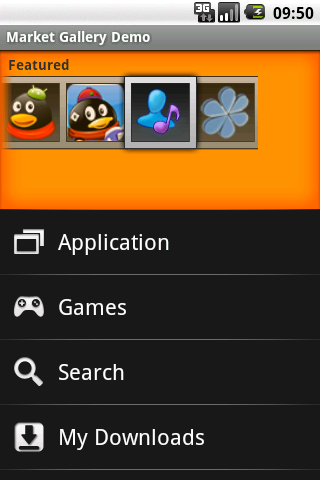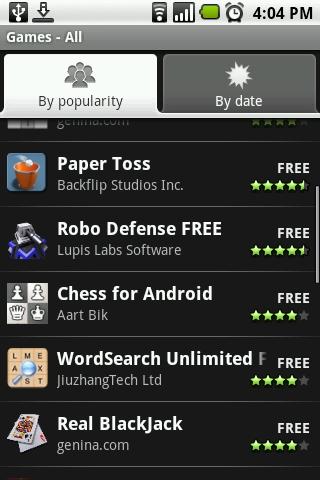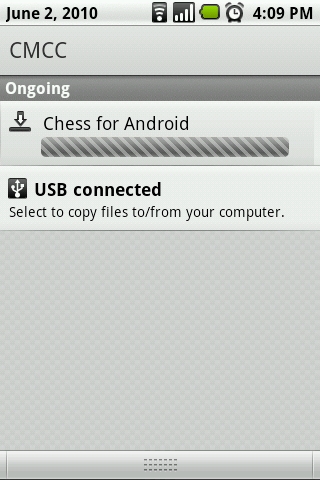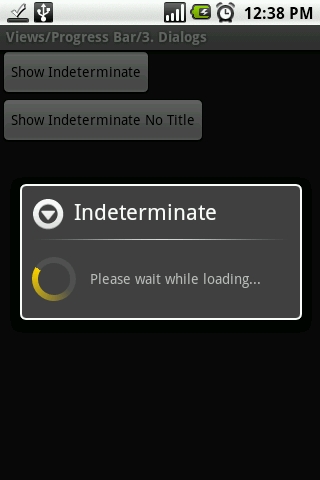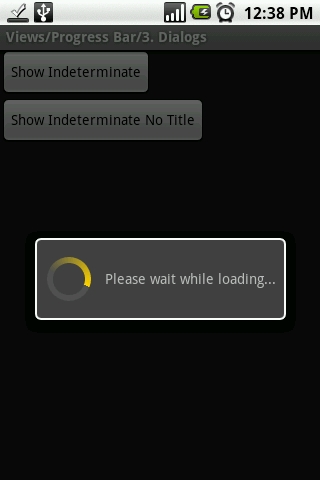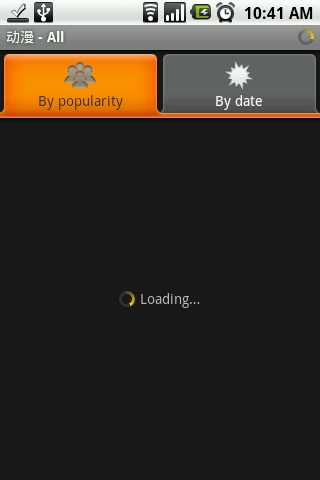public boolean areAllItemsEnabled() {
return false;
}
public boolean isEnabled(int position) {
return position != 0;
}Category: Android
Protocol Buffers in Android
Protocol Buffers in Android
无意中看到android market调试Log信息:”Lcom/google/common/io/protocol/ProtoBuf;”, 觉得好奇,搜索一下,ProtoBuf其源代码位于 external/protobuf/src/com/google/common/io/protocol,这个可不同于com.google.protobuf 包,后者是Google标准官方实现,com.google.common.io.protocol是Android平台上的,提供的接口,可以在这里查阅 http://www.androidjavadoc.com/m5-rc15/com/google/common/io/protocol/ProtoBuf.html
在 cupcake源代码目录下搜索ProtoBuf,没有找到使用ProtoBuf的相干代码。目前我发现只有android market使用这个库,market的数据交换格式不是什么xml或json,当然采用Google自家发明的Protocol Buffers。
update: 2010/08/19: 下载了 Android 2.2的代码,发现external/protobuf/目录不见了,被整进了 GoogleServicesFramework.apk 这个包,美曰其名: Google 服务框架。
How to Use Android Downloads Provider
“Good programmers write solid code, while great programmers reuse the code of good programmers”
— W. Jason Gilmore, the author of “Beginning PHP and MySQL”
In Android Platform, it supports some ways to download files from URLs via HttpURLConnection or HttpClient, or DownloadProvider.When you write an android programm with Eclipse, try to import:
import android.provider.DownloadsThe Eclipse gives a red error prompting and complains:
The import android.provider.Downloads cannot be resolvedOops…
The download manager is not part of the public SDK, and there are no relational API description in Android developers Reference.Comment in sources frameworks/base/core/java/android/provider/Downloads.java, says: “For 1.0 the download manager can’t deal with abuse from untrusted apps, so this API is hidden.” Refer to the document description from: packages/providers/DownloadProvider/docs/index.html. we Know that Browser / Gmail / Market / Updater depend on the download manager. Yes, show some screenshots in the market:
We maybe can’t compile with Eclipse, but we can write an Android.mk makefile, use mmm to do it.
DownloadProvider is very easy to use.First, declare permission in AndroidManifest.xml:
<uses-permission
android:name="android.permission.INTERNET"
>
</uses-permission>
<uses-permission
android:name="android.permission.ACCESS_DOWNLOAD_MANAGER"
>
</uses-permission>And then just need to fill some field values:
ContentValues values = new ContentValues();
String url = "https://blog.lytsing.org/wp-content/uploads/2010/06/android_downloadprovider_market.jpg";
values.put(Downloads.URI, url);
values.put(Downloads.MIMETYPE, "image/jpeg");
values.put(Downloads.FILENAME_HINT, getFullFilename("android_downloadprovider_market.jpg"));
values.put(Downloads.TITLE, "screenshot");
values.put(Downloads.DESCRIPTION, "screenshot file for DownloadProvider Demo");
values.put(Downloads.VISIBILITY, Downloads.VISIBILITY_VISIBLE);
values.put(Downloads.NOTIFICATION_CLASS, "org.lytsting.android.downloads.DownloadReceiver");
values.put(Downloads.NOTIFICATION_PACKAGE, "org.lytsting.android.downloads");
getContentResolver().insert(Downloads.CONTENT_URI, values);
private String getFullFilename(String filename) {
return Environment.getExternalStorageDirectory().toString() + "/download/" + filename);
}Notes
Downloads.FILENAME_HINT, for a demo, here, I put the file into SD Card, the download directory, without checking any exception.
Downloads.NOTIFICATION_CLASS, you want to write a DownloadReceiver class, which extends BroadcastReceiver, and handle the message Downloads.DOWNLOAD_COMPLETED_ACTION or Downloads.NOTIFICATION_CLICKED_ACTION. like this:
public class DownloadReceiver extends BroadcastReceiver {
static final String TAG = "DownloadReceiver";
@Override
public void onReceive(Context context, Intent intent) {
Log.d(TAG, intent.getAction());
if (intent.getAction().equals(Downloads.NOTIFICATION_CLICKED_ACTION)) {
Intent activityIntent = new Intent(Intent.ACTION_VIEW);
activityIntent.setFlags(Intent.FLAG_ACTIVITY_NEW_TASK);
activityIntent.setClass(context, Downloads.class); // Downloads Activity
try {
context.startActivity(activityIntent);
} catch (ActivityNotFoundException ex) {
Log.d(TAG, "no activity for Downloads.NOTIFICATION_CLICKED_ACTION" + ex);
}
} else if (intent.getAction().equals(Downloads.DOWNLOAD_COMPLETED_ACTION)) {
// balabala
}
}
}By here, we need to modify the AndroidManifest.xml, add:
<receiver
android:name=".DownloadReceiver"
android:permission="android.permission.SEND_DOWNLOAD_COMPLETED_INTENTS"
android:exported="true" >
<intent-filter>
<action
android:name="android.intent.action.DOWNLOAD_COMPLETED">
</action>
</intent-filter>
<intent-filter>
<action
android:name="android.intent.action.DOWNLOAD_NOTIFICATION_CLICKED">
</action>
<category
android:name="android.intent.category.DEFAULT">
</category>
<data
android:scheme="content">
</data>
</intent-filter>
</receiver> Maybe, you don’t like show the the Download state in status bar, just change Downloads.VISIBILITY_VISIBLE to Downloads.VISIBILITY_HIDDEN
and even, maybe you would like to show the download progress in the Activity, little case.
Cursor c = getContentResolver().query(
Downloads.CONTENT_URI, new String[] {
Downloads._ID,
Downloads.CURRENT_BYTES,
Downloads.TOTAL_BYTES,
Downloads.STATUS },
" " + Downloads.MIMETYPE + " = 'image/jpeg'", null,
Downloads._ID);
if (c == null) {
return;
}
// Columns match projection in query above
final int idColumn = 0;
final int currentBytesColumn = 1;
final int totalBytesColumn = 2;
final int statusColumn = 3;
c.moveToFirst();
long totalBytes = c.getLong(totalBytesColumn);
long currentBytes = c.getLong(currentBytesColumn);
c.close();Add a ProgressBar and a Handler to display and refresh the progress, I suppose you should know how to do. You also can write a class extends ContentObserver to observer the download status.
The last step, delete the history data:
getContentResolver().delete(Downloads.CONTENT_URI,
"(" + Downloads.TITLE + " = 'screenshot')", null);This code snippet should be write into a function in really code.
Read the code packages/apps/Browser for a more complete example.
Update:Since Android 2.2, the Downloads’s api has changed, they put some variables input a sub class which named Impl, so you should check it in the source code.
如何学习Android应用程序的开发
昨天一同学问我,如何快速的学习Android应用程序开发? 之前的一位同事也问过我,我也只是大概的说说看哪些资料。为避免更多的人问我,所以有必要写写。
1. 开发环境搭建。自行Google。英文好的,看官方网 http://developer.android.com/ 访问不了的,可以访问它的镜像 http://androidappdocs.appspot.com/index.html
2. 在模拟器上运行 ApiDemos,全部点一遍,看看Android都提供了些什么界面效果,心里有个印象。最好把ApiDemos的代码,看它个两三遍。我到过深圳南山书城,看了好几本国内出的Android书籍,一本书都没翻多久,就看完了,没啥看头,因为大部分内容ApiDemos都有了呀。
3. Java的学习。
Android应用程序是用Java写的,像我这样从C/C++阵营过来的,开始真的很抵触。《Thinking in Java》 ??? No! 没时间玩这东西,当做参考书还行,不懂就翻翻。宝岛台湾的林信良老师写的《Java学习笔记》,还不错。
http://caterpillar.onlyfun.net/Gossip/JavaGossip-V1/JavaGossip.htm
http://caterpillar.onlyfun.net/Gossip/JavaGossip-V2/JavaGossip2.htm
大约花一个礼拜的晚上时间学习,基本够用。
4. 学习资料
(1) 网站
官网 developer.android.com,英文差的同学,也要硬着头皮看,在网上搜来搜去,其实大部分东西都是从这拷贝过去的,从而浪费了大把的时间。国内的android论坛,好像就javaeye文章质量高一点,其他的不知道。我一直上国外的 http://www.anddev.org/ 它有两个版面 Novice Tutorials和Code Snippets for Android,有教程,可以下载代码编译运行,初学者最喜欢这样的了。不像一些网站,下载代码还要扣积分等其他7788的,一看就没什么好感。
(2) 书籍
就只推荐三本,其他的没看过,不好评论。
Mark L. Murphy: 《The Busy Coder’s Guide to Android Development》
Chris Haseman:《Android Essentials》
高煥堂:《Android 應用框架原理與程式設計36 技》
初学者最好不要第一本书就看高的书,因为一些东西他讲起来莫名其妙,搞复杂了,一看developer.android.com英文原版的资料,噢!英文描述这么简单啊。
(3) Blogs
请参看 http://wiki.andmob.org/blogs
(4) 阅读代码
除了上面所说的ApiDemos的代码,还有SDK下提供的Samples目录下其他示例代码,还有Google公司提供的Demo代码,它们在:
http://code.google.com/p/apps-for-android/
———–
2010/6/11 补充内容:今天在网上找chrome代码阅读,看到Venus神庙的 Android学习入门http://www.cnblogs.com/duguguiyu/archive/2010/01/23/1654559.html
感觉不错,也推荐给大家,Venus神庙写作水平不错,比我好N倍。
Android Market的 Loading效果
<?xml version="1.0" encoding="utf-8"?>
<LinearLayout
xmlns:android="http://schemas.android.com/apk/res/android"
android:gravity="center_vertical|center_horizontal"
android:orientation="horizontal"
android:id="@+id/fullscreen_loading_indicator"
android:visibility="gone"
android:layout_width="fill_parent"
android:layout_height="fill_parent"
>
<ProgressBar
android:layout_gravity="center_vertical"
android:layout_width="wrap_content"
android:layout_height="wrap_content"
style="?android:attr/progressBarStyleSmall"
>
</ProgressBar>
<TextView
android:id="@+id/current_action"
android:layout_width="wrap_content"
android:layout_height="wrap_content"
android:layout_marginLeft="5.0dip"
android:text="@string/loading"
>
</TextView>
</LinearLayout>
<?xml version="1.0" encoding="utf-8"?>
<FrameLayout
xmlns:android="http://schemas.android.com/apk/res/android"
android:layout_width="fill_parent"
android:layout_height="fill_parent"
>
<LinearLayout
android:orientation="vertical"
android:id="@+id/main_info"
android:visibility="gone"
android:layout_width="fill_parent"
android:layout_height="fill_parent"
>
</LinearLayout>
<include
android:visibility="visible"
android:layout_width="fill_parent"
android:layout_height="fill_parent"
layout="@layout/fullscreen_loading_indicator"
>
</include>
</FrameLayout>
package org.lytsing.android.loading;
import android.app.Activity;
import android.os.Bundle;
import android.widget.LinearLayout;
public class Loading extends Activity {
private LinearLayout mLoadingLayout;
/** Called when the activity is first created. */
@Override
public void onCreate(Bundle savedInstanceState) {
super.onCreate(savedInstanceState);
setContentView(R.layout.main);
// TODO: dismiss the loading, use this snippet code.
//mLoadingLayout = (LinearLayout)findViewById(R.id.fullscreen_loading_indicator);
//mLoadingLayout.setVisibility(View.GONE);
}
}